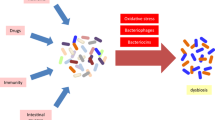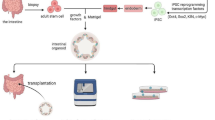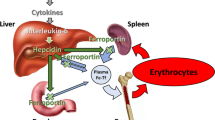Abstract
Background and Aims
Intestinal alkaline phosphatase (IAP) is a gut mucosal defense factor known to dephosphorylate lipopolysaccharide (LPS); however, the role of IAP in the gut response to luminal bacteria remains poorly defined. We investigated immune responses of wild-type (WT) and IAP-knockout (IAP-KO) mice to LPS and Salmonella typhimurium challenges.
Methods
Cryostat sectioning and standard indirect immunohistochemical staining for major histocompatibility complex (MHC) class II molecules were performed on liver tissue from WT and IAP-KO mice. WT and IAP-KO mice were orally gavaged with S. typhimurium; bacterial translocation to mesenteric nodes, liver, and spleen was determined by tissue homogenization and plating. In other experiments, WT and IAP-KO mice received intraperitoneal injections of LPS, with subsequent quantification of complete blood counts and serum interleukin (IL)-6 by enzyme-linked immunosorbent assay (ELISA). WT and IAP-KO whole blood were plated and stimulated with LPS and Pam-3-Cys, followed by cytokine assays.
Results
Immunohistologic liver examinations showed increased expression of MHC class II molecules in IAP-KO mice. Following S. typhimurium challenge, WT mice appeared moribund compared with IAP-KO mice, with increased bacterial translocation. WT mice had >50% decrease (P < .005) in platelets and 1.8-fold (P < .05) increased serum IL-6 compared with IAP-KO mice in response to LPS injections. IAP-KO whole-blood stimulation with LPS and Pam-3-Cys resulted in increased IL-6 and tumor necrosis factor (TNF)-alpha secretion compared with WT.
Conclusions
IAP-KO mice exhibit characteristics consistent with local LPS tolerance. Whole-blood response of IAP-KO mice did not reflect systemic tolerance. These data suggest that IAP is a local immunomodulating factor, perhaps regulating LPS–toll-like receptor 4 (TLR4) interaction between commensal microflora and intestinal epithelium.




Similar content being viewed by others
References
Goldberg RF, Austen WG Jr, Zhang X, et al. Intestinal alkaline phosphatase is a gut mucosal defense factor maintained by enteral nutrition. Proc Natl Acad Sci U S A. 2008;105(9):3551–3556.
Bates JM, Akerlund J, Mittge E, Guillemin K. Intestinal alkaline phosphatase detoxifies lipopolysaccharide and prevents inflammation in zebrafish in response to the gut microbiota. Cell Host Microbe. 2007;2(6):371–382.
Poelstra K, Bakker WW, Klok PA, Kamps JA, Hardonk MJ, Meijer DK. Dephosphorylation of endotoxin by alkaline phosphatase in vivo. Am J Pathol. 1997;151(4):1163–1169.
Poelstra K, Bakker WW, Klok PA, Hardonk MJ, Meijer DK. A physiologic function for alkaline phosphatase: endotoxin detoxification. Lab Invest. 1997;76(3):319–327.
Hodin RA, Graham JR, Meng S, Upton MP. Temporal pattern of rat small intestinal gene expression with refeeding. Am J Physiol. 1994;266(1 Pt 1):G83–G89.
McClure RJ, Newell SJ. Randomised controlled study of clinical outcome following trophic feeding. Arch Dis Child Fetal Neonatal Ed. 2000;82(1):F29–F33.
Moore EE, Jones TN. Benefits of immediate jejunostomy feeding after major abdominal trauma—a prospective, randomized study. J Trauma. 1986;26(10):874–881.
Narisawa S, Huang L, Iwasaki A, Hasegawa H, Alpers DH, Millan JL. Accelerated fat absorption in intestinal alkaline phosphatase knockout mice. Mol Cell Biol. 2003;23(21):7525–7530.
Nakano T, Inoue I, Koyama I, et al. Disruption of the murine intestinal alkaline phosphatase gene Akp3 impairs lipid transcytosis and induces visceral fat accumulation and hepatic steatosis. Am J Physiol Gastrointest Liver Physiol. 2007;292(5):G1439–G1449.
Rath HC, Schultz M, Freitag R, et al. Different subsets of enteric bacteria induce and perpetuate experimental colitis in rats and mice. Infect Immun. 2001;69(4):2277–2285.
Elson CO. Experimental models of intestinal inflammation: new insights into mechanisms of mucosal homeostasis. In: M.E.L. Ogro PL, Bienenstock J, Mestecky J, Strober W, McGhee JR, eds. Mucosal Immunology. San Diego: Academic Press; 1999:1007–1024.
Torres MI, Lorite P, Lopez-Casado MA, Rios A. A new approach using tissue alkaline phosphatase histochemistry to identify Crohn’s disease. Pathol Res Pract. 2007;203(6):485–487.
Tuin A, Poelstra K, de Jager-Krikken A, et al. Role of alkaline phosphatase in colitis in man and rats. Gut. 2009;58(3):379–387.
Lehner MD, Ittner J, Bundschuh DS, van Rooijen N, Wendel A, Hartung T. Improved innate immunity of endotoxin-tolerant mice increases resistance to Salmonella enterica serovar typhimurium infection despite attenuated cytokine response. Infect Immun. 2001;69(1):463–471.
Rayhane N, Fitting C, Lortholary O, Dromer F, Cavaillon JM. Administration of endotoxin associated with lipopolysaccharide tolerance protects mice against fungal infection. Infect Immun. 2000;68(6):3748–3753.
Lu M, Varley AW, Ohta S, Hardwick J, Munford RS. Host inactivation of bacterial lipopolysaccharide prevents prolonged tolerance following gram-negative bacterial infection. Cell Host Microbe. 2008;4(3):293–302.
Department of Health, E.a.H.S., Publication no. 85–23, N.I.o. Health, Editor. 1985.
Enomoto N, Ikejima K, Bradford BU, et al. Role of Kupffer cells and gut-derived endotoxins in alcoholic liver injury. J Gastroenterol Hepatol. 2000;15(Suppl):20–25.
Thurman RG. II. Alcoholic liver injury involves activation of Kupffer cells by endotoxin. Am J Physiol. 1998;275(4 Pt 1):G605–G611.
Jephthah-Ochola J, Urmson J, Farkas S, Halloran PF. Regulation of MHC expression in vivo. Bacterial lipopolysaccharide induces class I and II MHC products in mouse tissues by a T cell-independent, cyclosporine-sensitive mechanism. J Immunol. 1988;141(3):792–800.
Kaufman JF, Auffray C, Korman AJ, Shackelford DA, Strominger J. The class II molecules of the human and murine major histocompatibility complex. Cell. 1984;36(1):1–13.
Takahashi M, Ogasawara K, Takeda K, et al. LPS induces NK1.1+ alpha beta T cells with potent cytotoxicity in the liver of mice via production of IL-12 from Kupffer cells. J Immunol. 1996;156(7):2436–2442.
Franco A, Barnaba V, Natali P, Balsano C, Musca A, Balsano F. Expression of class I and class II major histocompatibility complex antigens on human hepatocytes. Hepatology. 1988;8(3):449–454.
Wiegard C, Wolint P, Frenzel C, et al. Defective T helper response of hepatocyte-stimulated CD4 T cells impairs antiviral CD8 response and viral clearance. Gastroenterology. 2007;133(6):2010–2018.
Coffee KA, Halushka PV, Wise WC, Tempel GE, Cook JA. Endotoxin tolerance differentially alters hemodynamic responses to a thromboxane A2 mimetic and phenylephrine. J Cardiovasc Pharmacol. 1991;17(1):20–26.
Beeson PB. Development of tolerance to typhoid bacterial pyrogen and its abolition by reticulo-endothelial blockade. Proc Soc Exp Biol Med. 1946;61:248–250.
Garg S, Bal V, Rath S, George A. Effect of multiple antigenic exposures in the gut on oral tolerance and induction of antibacterial systemic immunity. Infect Immun. 1999;67(11):5917–5924.
Favorite GO, Morgan HR. Effects produced by the intravenous injection in man of a toxic antigenic material derived from eberthella typhosa: clinical, hematological, chemical and serological studies. J Clin Invest. 1942;21(5):589–599.
Greisman SE, Woodward WE. Mechanisms of endotoxin tolerance. 3. The refractory state during continuous intravenous infusions of endotoxin. J Exp Med. 1965;121:911–933.
Madonna GS, Peterson JE, Ribi EE, Vogel SN. Early-phase endotoxin tolerance: induction by a detoxified lipid A derivative, monophosphoryl lipid A. Infect Immun. 1986;52(1):6–11.
Henricson BE, Benjamin WR, Vogel SN. Differential cytokine induction by doses of lipopolysaccharide and monophosphoryl lipid A that result in equivalent early endotoxin tolerance. Infect Immun. 1990;58(8):2429–2437.
Mathison JC, Ulevitch RJ. The clearance, tissue distribution, and cellular localization of intravenously injected lipopolysaccharide in rabbits. J Immunol. 1979;123(5):2133–2143.
Munford RS, Hall CL, Lipton JM, Dietschy JM. Biological activity, lipoprotein-binding behavior, and in vivo disposition of extracted and native forms of Salmonella typhimurium lipopolysaccharides. J Clin Invest. 1982;70(4):877–888.
Munford RS, Hall CL, Dietschy JM. Binding of Salmonella typhimurium lipopolysaccharides to rat high-density lipoproteins. Infect Immun. 1981;34(3):835–843.
Vesy CJ, Kitchens RL, Wolfbauer G, Albers JJ, Munford RS. Lipopolysaccharide-binding protein and phospholipid transfer protein release lipopolysaccharides from gram-negative bacterial membranes. Infect Immun. 2000;68(5):2410–2417.
Wurfel MM, Kunitake ST, Lichenstein H, Kane JP, Wright SD. Lipopolysaccharide (LPS)-binding protein is carried on lipoproteins and acts as a cofactor in the neutralization of LPS. J Exp Med. 1994;180(3):1025–1035.
Kitchens RL, Thompson PA, Viriyakosol S, O’Keefe GE, Munford RS. Plasma CD14 decreases monocyte responses to LPS by transferring cell-bound LPS to plasma lipoproteins. J Clin Invest. 2001;108(3):485–493.
Asari Y, Majima M, Sugimoto K, Katori M, Ohwada T. Release site of TNF alpha after intravenous and intraperitoneal injection of LPS from Escherichia coli in rats. Shock. 1996;5(3):208–212.
Sugimoto K, Kawamura M, Katori M, Shindo M, Ohwada T. Transmigration routes and a delayed systemic hypotension in rats after intraperitoneal injection of endotoxin from Escherichia coli. Circ Shock. 1993;41(3):185–196.
Ghezzi P, Sacco S, Agnello D, Marullo A, Caselli G, Bertini R. LPS induces IL-6 in the brain and in serum largely through TNF production. Cytokine. 2000;12(8):1205–1210.
Fitting C, Dhawan S, Cavaillon JM. Compartmentalization of tolerance to endotoxin. J Infect Dis. 2004;189(7):1295–1303.
Rakoff-Nahoum S, Paglino J, Eslami-Varzaneh F, Edberg S, Medzhitov R. Recognition of commensal microflora by toll-like receptors is required for intestinal homeostasis. Cell. 2004;118(2):229–241.
Madara J. Building an intestine—architectural contributions of commensal bacteria. N Engl J Med. 2004;351(16):1685–1686.
Ohno A, Isii Y, Tateda K, et al. Role of LPS length in clearance rate of bacteria from the bloodstream in mice. Microbiology. 1995;141(Pt 10):2749–2756.
Acknowledgments
Grant support: (1) National Institutes of Health Grant R01DK050623; (2) National Institutes of Health Grant R01DK047186; (3) National Institutes of Health Grant T32DK007754.
Conflicts of interest
No conflicts of interest are reported
Author information
Authors and Affiliations
Corresponding author
Rights and permissions
About this article
Cite this article
Chen, K.T., Malo, M.S., Beasley-Topliffe, L.K. et al. A Role for Intestinal Alkaline Phosphatase in the Maintenance of Local Gut Immunity. Dig Dis Sci 56, 1020–1027 (2011). https://doi.org/10.1007/s10620-010-1396-x
Received:
Accepted:
Published:
Issue Date:
DOI: https://doi.org/10.1007/s10620-010-1396-x




